Introduction:

This paper is a work in progress, based especially on field experience by the author of "The Herring Gull Assemblage" in southwest Japan and South Korea in every winter between 1990 and the present. It presents the main forms considered to occur in South Korea, summarizing selected identification criteria of especially juvenile/first winter and winter adult plumages and suggests their distribution within the country: information at present largely unavailable to "gullers". The proposed identification criteria (highlighted by images taken within South Korea) and discussion on taxonomic decisions, aims to elicit considered responses from other "gullers", both within and outside of the region, so that after further revision the paper can then be submitted to an appropriate medium for publication (with all contributions fully acknowledged). In its present form, it already expands on descriptions included in The Birds Of South Korea (a video produced by Charlie and Nial Moores), and adds a ’Korean perspective’ to the ground-breaking paper on gull systematics published in the Hong Kong Bird Report by Kennerley et al (1995), and especially to two excellent papers recently published in Dutch Birding (Yesou 2001; Yesou 2002). All three papers contain extensive reviews of the literature and details of museum specimens and nesting colonies (elements which fall outside of the scope of this paper), but do not provide necessary details on juvenile or first winter plumages, or examples of several apparently identifiable forms regularly observed in Korea.
- Discussion of the Assemblage in Korea, with special reference to Yésou (2001 & 2002).
- Taimyrensis versus yellow-legged Vega Gull.
- Mongolian Gull: subspecies of Vega or specifically distinct?
- Summary
"The Herring Gull Assemblage" in South Korea.

Photos taken in December - February, © Charlie Moores and Kim Hyun-Tae.
Taxa belonging to the "Herring Gull Assemblage" (a term apparently coined by de Knijff et al) pose one of the toughest identification challenges in South Korea, even though several forms appear to be widely distributed in winter. Although only ca 400km north-south and roughly the same west-east, the country’s coastline is long and varied (with extensive tidal-flats and wide bays with numerous indentations and offshore islands along the west coast, the eastern flank of the Yellow Sea; deeper bays with narrower estuaries and widespread industry along the south coast; and a mix of rock and sand beaches with deep sea fishing harbors along the east coast), and a visit to almost any river-mouth, beach or harbor in winter provides the birder with a fairly bewildering range of gulls.
Along with the widespread Black-tailed Larus crassirostris, Common L. (canus) kamtschatschensis and Black-headed Gulls L. ridibindus sibiricus, the most numerous "Herring Gull types" typically range from (1) small and dark-backed adults, with heavily streaked hind napes, and yellowish legs, through (2) slightly larger, front heavy, dirty-grey and heavily streaked, pink-legged birds, through to (3) white-headed adults, heavy, with cleaner, lighter grey upperparts and invariably pink legs.
It is apparent that all three types can occur together, but in significantly differing ratios of abundance, with the paler-mantled white-headed adults being the most numerous form on freshwater (e.g. on the Han River in Seoul), and the other two more numerous on beaches and harbors along the coast.
Mixed in with these three main types, especially in coastal areas, is a range of birds showing intermediate or unclear characteristics. The presence of a bewildering range of individuals, the lack of easily accessible (or intelligible) literature, and the general lack of interest in gulls amongst the very small number of Korean birders/ornithologists has conspired to prevent much consensus on identification. This has prevented the domestic publication of any significant papers on the forms found here in winter, or even of those recently found nesting on islands off the Korean west coast, although much discussion has been engendered through several websites that focus largely on gulls, most notably Kim Hyun-Tae’s in Seosan and the Ujiharas’ in Japan.
Consequently, although the names given in the leading field guide for Korea (Lee, Koo & Park, 2000) for the three main types described above are (1) Heuglin’s Gull L. heuglini, (2) Herring Gull L. argentatus and (3) Yellow-legged Gull L. cachinnans, most gull enthusiasts probably actually regard these as (1)Taimyr Gull Larus heuglini taimyrensis, (2) Vega Gull L. vegae vegae and L. vegae birulai, and (3) Mongolian Gull L. (vegae) mongolicus, or use these English names without having an opinion on taxonomy. The wide range of individuals showing "mixed characteristics" are regarded either largely as extreme variation within taxa whose limits (both phenotypic and geographical) are not well-known, or more often as hybrid taimyrensis X birulai. (In the case of hybridization, it is widely accepted that it "has occurred more often than usually thought between sympatric taxa of large white-headed gulls" (Yesou 2002), and where an extralimital species occurs in the breeding range of another "close" species.)
"Phenotypic variation and systematics of Mongolian Gull" (Yesou, 2001), and "Trends in systematics" (Yesou 2002) are both extremely well-researched and useful papers in helping consider this complex, with the former documenting the appearance and measurements of breeding Mongolian Gull at sites on Lake Baikal, and the latter offering a summarized presentation of all of the "taxa of the Larus argentatus-cahninnans-fuscus complex, intending to propose a reappraisal of their classification" (Yesou, 2002). Both papers concentrate on describing the (breeding-plumage) adult forms of the various taxa, most particularly their mantle colour, primary patterning and leg colour, as well as summarizing the results of recent mtDNA studies and other information on breeding behavior and distribution. This leads to Yesou’s reappraisal of the various taxa, and some suggested changes in nomenclature.
In summary, of the forms suspected of occurring in South Korea, Yesou’s classification recognizes Heuglin’s Gull Larus heuglini as a "good species"; considers "taimyrensis" and "birulai" as invalid taxa; Vega Gull as the nominate subspecies of East Siberian Gull L. vegae vegae, and Mongolian Gull as "provisionally" a subspecies of vegae, L.vegae mongolicus (contra Yesou 2001).
In addition, American Herring Gull L. smithsonianus (claimed in South Korea on one or two occasions) is recognized as a distinct species (apparently showing strong mtDNA divergence from European taxa, and from vegae within the range of "birulai").
A last form, Baraba or Steppe Gull, which might have occurred in Korea at least once, is considered a borderline species, either distinct or a subspecies not of other southern cachinnans gulls, but of the northern-nesting Heuglin’s Gull.
Before further considering the taxonomic arrangement presented by Yesou (2002) it is necessary to describe in some detail the typical appearance and distribution of the main forms of the Herring Gull Assemblage found in South Korea, namely those which are generally being called Vega, Taimyr and Mongolian Gull(from hereon termed the Assemblage). Each account describes the taxon’s distribution in South Korea in general terms, the overall structure of the forms (which is considered a useful though rather variable feature, Ujihara in lit., pers obs), and then concentrates on the appearance of juvenile/first winter and winter adult plumages. The taxonomy of the forms will be further discussed after the descriptions.
It is important, though, to stress that there is still much to be learnt about these taxa (which nest and winter across a vast region) and that additionally several features typically used in separating individuals of e.g. the argentatus-cachinnans-fuscus complex in western Europe (including leg colour, mantle colour and primary patterning) appear on present knowledge to be less useful in separating Far East Asian gulls that nevertheless do typically show distinct juvenile, first winter and other non-breeding plumages.
Vega Gull, including Birula Gull
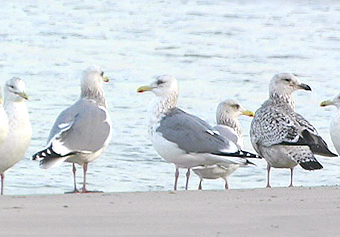
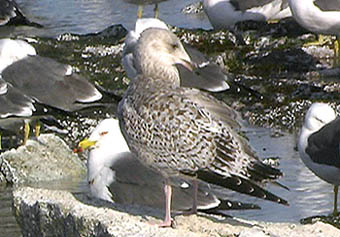
Photo © Charlie Moores
This is generally considered to be the most widespread and numerous of the group occurring in South Korea (and also Japan). If birulai is included, it is also probably the most variable in appearance. Main autumn arrivals take place in mid- to late October, with significant numbers remaining through the winter (concentrations of 1 000 plus occur at several sites, even in December and January). Most northward movement appears to take place from perhaps mid-February, through March. Only small numbers remain into April and early May.
Vega Gull is widespread, favouring harbors, rocky shores, estuaries and (in smaller numbers) open tidal-flats and rivers. Birds use a variety of feeding techniques, perhaps most often scavenging around fishing boats, or picking items (including small fish) from near the surface of the water.
Structure
Vega is typically the least well-proportioned of the forms occurring in Korea, often looking rather short-legged, front heavy and rather large-headed and long-necked, with a fairly deep chest but "flat belly" (though some can appear oddly small-headed or fuller-bodied). The head is typically rather flat, with a rounded rear crown, while the bill is typically mid-length to long, with a fairly obvious gonydeal angle, and often a fairly obvious hooked tip to the upper mandible. Standing birds typically look "slope-backed", with the lower body angled down, and the slightly drooped wings nearly touching the ground. They have a "weak" rear end, with a fairly short primary extension beyond the tail (only slightly longer than that shown by e.g. Slaty-backed Gull L. schistisagus) though some can look longer-winged. The very largest individuals can also look rather more barrel-bodied and powerful, approaching Slaty-backed or larger individuals of American Herring Gulls in overall structure.
In flight, Vega tends to look shorter- and broader-winged than either Mongolian or Taimyr Gull.
Plumage
Juvenile and first winters are highly variable, some appearing dark overall while others appear rather paler.
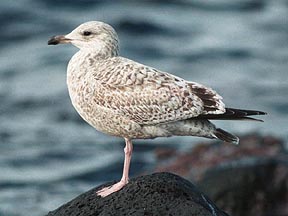
Pale and long-winged, this perhaps appears structurally closer to birulai than vegae. Note the barred greater coverts, notched and relatively intact tertials, and the broad blackish tail band.
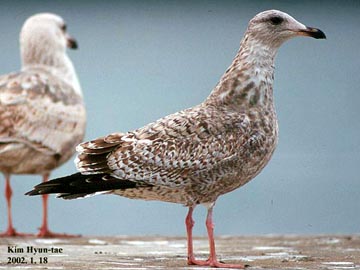
Rather coarsely marked and dark, this ill-proportioned individual perhaps appears structurally closer to vegae.

December Photo © Nial Moores.
Individual showing several characteristics suggestive of smithsonianus, including a wholly blackish tail (with only laddered white outers), a strikingly dark bar across part of the greater coverts, long primary projection beyond the tail and notched tertials.
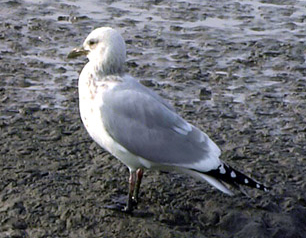
Photo © Charlie Moores.

Photo © Charlie Moores.
Paler birds (perhaps largely attributable to northernmost populations or birulai?) can be somewhat suggestive of a pale Thayer’s Gull L. thayeri, being a light grey-brown tone with grey-brown concentrated around the eye; obvious, clean looking fringes to the mantle and wing coverts; and obviously notched, dark-centred tertials. They show obvious barring across all of the greater coverts, which often bleach paler still by mid-winter and appear very worn by February. Many of these paler birds appear somewhat lightly built.
Progressively darker birds can be much more suggestive of American Herring Gull. They have a dark brown sludgy look to much of the underparts (through until Dec-Jan), though even by October/November this is usually relieved by a rather pale and more spotted vent and undertail coverts, and a somewhat paler forehead, lores, chin and throat. The upperparts are also rather more darkly marked, with dark centers to the scapulars and often more solidly dark tertials on the closed wing which show a broad whitish fringe variably marked with brown "notches".
In flight, first winters show a very dark, contrasting secondary bar and a fairly weak pale blaze across the inner primaries (not as strong as depicted in Lee, Koo and Park, 2000). They also have a notably light brown (or even whitish) rump and barred or spotted uppertail coverts, which contrast strongly with a typically narrowly white-based blackish tail (though some birds can appear to show a significantly narrower black tail band, rather closer to Mongolian). The outermost tail feathers can often show pale and dark "laddering", especially basally. The underwing tends to appear rather plain and brownish.
Interestingly, a very few show a dark bar across part of the greater coverts: this could be intra-taxon variation within Vega, misidentification of extralimital American Herring Gull, or a result of hybridization, between either Vega, Heuglin’s, Mongolian, Slaty-backed or American Herring Gull. Most show largely dark bills with some dirty dark pink basally, which becomes increasingly obvious by ca January.
Winter adults appear rather dirty, with dark grey lead-toned upperparts; some, though, are distinctly paler-looking, and have generally been considered to be Birula Gull (following Kennerley et al, 1995 and Hoogendoorn et al 1996). Such birds show a rather icier-looking tone to the grey of the upperparts, and structurally look closer to the birds considered to be Taimyr Gull, in that they appear rather neat and compact; show rounded-looking heads and flattish-backs; a slightly longer primary projection; and a cleaner pink tone to the legs. In addition, they tend to have rather finer head streaking, without the smudgy look of most Vegas. They are scarce in South Korea, constituting probably less than 1 in 250 individuals.
According to Yesou (2002), there is little variation in mantle coloration of Vega Gull, though he states that the northernmost populations (nesting on the New Siberian Islands, which lie within the range ascribed for birulai) are the palest-mantled, while the westernmost and easternmost are the darkest. Most birds presently considered birulai presumably therefore refer to these more northern populations (see discussion section below).
As noted in Kennerley et al (1995) and Yesou (2002) there appears to be great variation in the extent of black on the outer primaries shown on the open wing; although rather extensive, it very seldom extends onto the outer wing coverts in adults (unlike in Mongolian). On the underwing, there is a strong contrast shown between the very pale underwing coverts, the broad, darker grey lower remiges and the broad white trail. This contrast is often rather more marked than in most Mongolian.
In mid-winter (December-January) most Vega show extensive grey-brown (tinged warmer) streaking and smudged "thumbprints" on the hindneck, across the neck sides, and often down the breast sides, with the most extreme looking hooded like Thayer’s or American Herring Gull. In ca 150 Vega checked in one flock in mid-January 2003 ca 1 in 4 or 1 in 5 looked hooded, with 2 individuals very darkly so.
The majority show obvious dark markings up onto the crown and around the eye, though smaller numbers show much weaker head markings, with most markings concentrated on the lower nape.
Many apparently start to become rather whiter-headed in February and are presumably Vega moving into breeding plumage. As Vega then show increased phenotypic resemblance to Mongolian, and their mantle coloration can overlap (Yesou, 2001; pers obs), many structurally atypical individuals become increasingly difficult to identify with confidence.
The majority of adult Vega Gull have largely dark eyes in winter, with the darkest looking solidly dark brown in the field. Around 50 out of 100 checked in mid-December 2002 looked dark-eyed, with ca 20 intermediate and 30 pale, while by mid-January 2003 (at a different site) ca 80 out of 100 looked dark-eyed, with ca 15 intermediate-pale, and only 2 clearly yellowish or whitish. All appear to show a deep red eye-ring. Bill colour of adults in the same mid-winter period is typically weak yellow, with an orangey-red gonys spot, and only occasional small blackish marks on the bill (that are seldom as extensive as on some Mongolian).
Leg colour of typical Vega (i.e. those showing typical structure as described above, lead grey mantles, heavy head streaking and dark eyes) is invariably pink.
Yesou (2002) states that the polymorphic Vega can be yellow-legged, but that this character declines in prevalence from west to east. It would appear that the form most often referred to in Japan and Korea as Vega therefore refers to the more eastern population alone. The vast majority of, if not all, Vega with yellowish tones to the legs show a variety of other differences suggestive of different taxa or hybridisation.

Photo © Kim Hyun-Tae
Although most birds showing "mixed characters" are generally considered to be taimyrensis x vegae/birulai hybrids, this bird (showing coarse head markings extending to the breast sides approaching vegae, but a more compact and neat structure suggesting taimyrensis) apparently also has a paler mantle than either. According to Yesou (2002), this should therefore be identified as a yellow-legged Birula Gull.
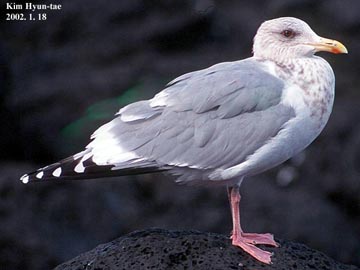
A rather long-winged, deep-chested and powerful individual.
Taimyr Gull or taimyrensis

Photo © Kim Hyun-Tae.
This taxon, generally considered to be the eastern subspecies of Heuglin’s Gull (e.g. Kennerley et al. 1995, Hoogendoorn et al. 1996), is fairly widespread in South Korea, especially in autumn and perhaps again in early spring, usually occurring in small concentrations of 3-5 or less per ca 100 Vega Gulls in mid-winter. It apparently arrives in the northern Yellow Sea in mid-September (Dierschke and Heintzenberg, 1994), with small numbers appearing in South Korea at the same time. Numbers apparently peak sharply in mid-October, when for example in 2002 ’pure’ flocks of 15-30 birds (comprising both adults and juveniles/first winters) occurred offshore from the west coast (somewhat contra the account in Birds of South Korea). Becoming scarcer in mid-winter, numbers apparently then increase again in February and March, suggesting that many individuals winter south of Korea: a suggestion supported by Kennerley et al. (1995), who consider it the most numerous taxon of the Assemblage in Hong Kong.
Opinion remains divided as to whether taimyrensis in Korea is almost entirely composed of hybrid Vega X Heuglin’s Gull (e.g. Carey in lit., 2001), or whether the taxon is highly variable in appearance.
Taimyr Gulls are most numerous in island harbours and around fishing boats at sea, with smaller numbers in estuaries and on sandy beaches. It is seldom found in freshwater habitats in South Korea. It also tends to be the least dominant in mixed groups of the three forms, often being harassed or displaced from a favored roost spot and otherwise seldom interacting with other larger taxa.
Structure

What are considered "typical" Taimyr Gulls appear neat and fairly compact, with short to medium length legs, shortish bills showing a weak gonydeal angle, and a rounded head shape. Compared with Vega they tend to look rather flat-backed and in direct comparison are usually smaller. They show a slightly longer primary projection beyond the tail, and appear longer and more narrow-winged in flight.
Plumage
Juveniles and first winters are strongly suggestive of (western forms) of Lesser Black-backed Gull L. fuscus graellsi, in that they appear rather dark, with solidly dark tertials showing no notching and only a narrow white fringe - which unlike Mongolian Gull’s are not prone to obvious wear early in the winter. In addition, they show an obvious dark band across the (outer) greater coverts. The brown tones overall are rather cleaner than those found in Vega (lacking any grey) and often include some rustiness on e.g. the hind neck and juvenile scapulars.
By December, many taimyrensis wear rather pale on the breast and especially on the head, at which time first winter scapulars often appear blackish-centred: often looking more neater overall than Vega.
The bill colour is invariably dark, often all-black into January, at which time both Vega and Mongolian Gull show some obvious pink on the bill.

First winter Taimyr Gull, January. Structurally distinct, note the rather dark greater coverts, the rusty tones to some feather centers and edges, and the largely dark bill.

In flight, first winters show further similarities to Lesser Black-backed Gull: they lack an obvious blaze on the base of the inner primaries; show a blackish secondary bar and a dark (though not black) bar across the greater coverts; and have a rather more obvious white rump and whiter bases to the tail feathers than shown by Vega.
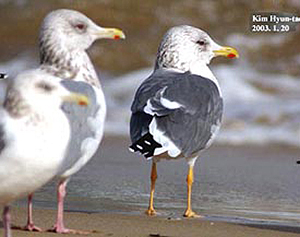
Photo © Kim Hyun-Tae.
Note the smaller size than vegae of this rather long-legged individual, and the extent of head streaking (much more extensive than shown by any Mongolian Gull types photographed at the same time of year).
So-called "typical" winter adults (which at most comprise probably less than half of the birds presently being called taimyrensis in Korea, the rest often being considered taimyrensis-vegae hybrids) have dark grey upperparts (i.e. more slaty and slightly darker than Vega and most Mongolian) and pinky-yellow, yellow or bright yellow legs.
The primary moult of many typically appears to be later than in Vegaor Mongolian (though the range in these taxa is perhaps not yet fully understood), with many still in active moult in December, by which time they also show fine streaking concentrated on the hindnape and around the eye, which itself is paler and yellower than most Vegas’. The bill is typically rather brighter than other taxa, with an obvious orangey-red gonys spot bleeding on to the upper mandible. Most show some dark markings near the gonys spot and a rather paler tip.
Birds of more variable appearance show a range of features suggesting vegae, including for example pink legs, heavier splotched head markings, or earlier than expected primary moult. Such birds most likely largely comprise pink-legged Taimyr Gulls (due e.g. to temporal changes), Birula Gulls and occasional/frequent hybrid Taimyr/Birula; such birds are considered in the discussion section below.
Heuglin’s Gull
Looking at the descriptions of nominate heuglini found in Grant (1986), Kennerley et al. (1995) and elsewhere, and comparing them with the range of the taimyrensis found in South Korea, it appears that nominate Heuglin’s Gull also occurs occasionally in South Korea (and neighboring Japan), with 3-4 observations of adults and and one suspected juvenile/first winter made by the author between 1998 and 2002. Though the adults appeared rather similar in coloration to some smaller taimyrensis, their head-streaking was more spotty and more confined to the hind-nape, and they showed striking structural differences: obviously more massive and powerful, with significantly longer legs. Interestingly, in interactions with other gulls (including Vega and Slaty-backed) they appeared both aggressive and dominant.

One possible first winter (photographed in December 2002) also appeared long-legged, very heavy billed and colder in plumage tones than taimyrensis, more suggestive of Great Black-backed Gull L. marinus than Lesser Black-backed Gull.

"Juveniles very similar to this are very often found in east Japan in autumn/winter" and are considered likely to be late-molting mongolicus (Ujihara in lit.). Similar to some darker mongolicus, this individual however shows a dark outer greater covert bar, a largely dark tail, and lacks the coarse hind-nape markings considered by the author more typical of that taxon.
Baraba Gull or barabensis
Considered either a distinct species or a subspecies of Heuglin’s Gull (Yesou, 2002), barabensis-type individuals have been observed in Korea one or two times, with one photographed by Arnoud van den Berg and M. Robb in October 2002.
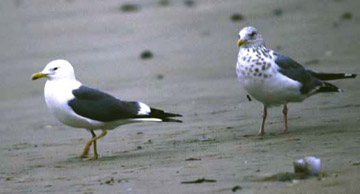
Photo © Arnoud van den Berg
This individual is included here as it appeared much more elongated and rather darker on the upperparts than typical taimyrensis, completely lacked head-streaking (unusual, but not exceptional for taimyrensis at this time of year), and showed a similarly weak scapular crescent to the depiction of summer barabensis in Yésou (2002). However, its identification remains unclear, due to uncertainties about the range in appearance of barabensis, including the extent of dark markings on the bill, and taimyrensis. Although structurally distinctive, this individual is considered by Ujihara (in lit.) to fall within the range of summer taimyrensis.



